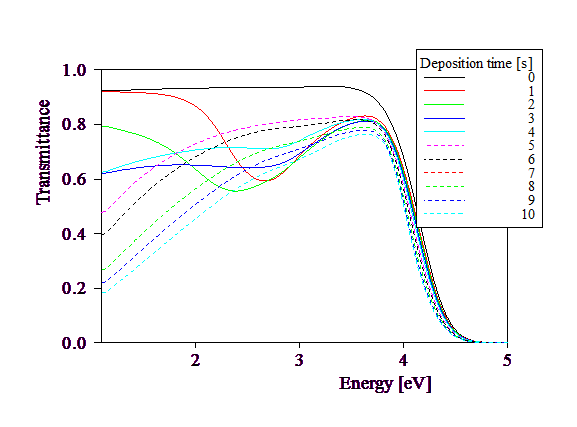In this section we show how the effective medium models built into SCOUT are applied. The goal is to describe the optical properties of an inhomogeneous silver layer on glass in the Vis/UV spectral range. The origin of the irregularities is the island growth that occurs during the first stages of silver deposition by sputtering.
Due to the inhomogeneities the silver layer has a response to electric fields which is very different from that of a homogeneous metal. Nevertheless, if the characteristic length scale of the inhomogeneities is much smaller than the light wavelength of the probing radiation, one can treat the material as a macroscopically homogeneous effective medium:

The optical properties of the silver layer can be described by a so-called effective dielectric function which is a suitable average of the dielectric functions of silver and air. But what is the 'suitable' average? The 'averaging rule' should depend on the microgeometry: If the metal islands are very far from each other there is no electric current transport in the system and the effective medium behaves like an insulator. In this case an effective medium theory should favour the vacuum component in the mixing of the two phases to the effective dielectric function. If, on the other hand, the islands would be very close to each other and metallic connections have developed already, the material will appear to the outside as a conducting metal. The effective medium would not be conducting as good as pure silver, but certainly much better than vacuum. Hence the silver dielectric function should have a significant weight in the averaging for this kind of network systems.
As mentioned in the technical manual, the Bergman representation is the most general effective medium theory. The effective dielectric function can always be written in this form:

The averaging of the dielectric functions (we choose vacuum to be the host or matrix material with dielectric function εM and silver as the embedded phase with dielectric function ε) depends on the volume fraction f of the embedded phase and the shape of the function g(n,f). The latter is called spectral density.
The volume fraction is a simple and intuitive quantity. In some cases, it can even be measured or is known from the sample preparation procedure. For a given volume fraction, the remaining question is the proper choice of g(n,f). In contrast to the volume fraction, this quantity cannot be handled intuitively. We need to develop some skills in order to make reasonable assumptions on the shape of spectral densities. This tutorial wants to shine some light on this topic.
From a series of transmission spectra (recorded on sputtered silver layers on glass) we pick those obtained for small deposition times. Here the island growth occurs and we need an effective medium description. The spectra provided with this tutorial as files labeled 0.std, 1.std, 2.std, ... 10.std (all in standard format) are the following:

First we will verify that the assumption of a homogeneous silver layer leads to difficulties for the thinner layers. Then some simple effective medium approaches are tested. Finally a Bergman representation object is used to determine a suitable spectral density which fits the experimental data.
If you think you need to read something about effective medium theories and the Bergman representation you will find some references in the technical manual.